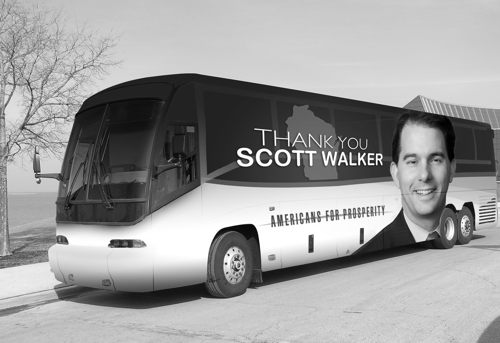The Ultimate Guide to Building a Successful Conservative Grassroots Movement
First of all, what is a grassroots campaign, anyway? Grassroots is a label often applied to any organization in which “ordinary people are regarded as the main body of an organization’s membership.” In other words, grassroots means building from the ground up.
A grassroots campaign is made up of real-world individuals who care about the issues their organization cares about.
Why Is Grassroots Such A Powerful Concept?
There are a lot of reasons why grassroots movements are effective and powerful. Before anyone can think about creating a successful grassroots campaign, it is important to understand why these campaigns are successful in the first place.1. IT IS AUTHENTIC
Grassroots movements are authentic. They can’t be faked or orchestrated by outside groups. The authenticity of grassroots can be felt by those involved, by outsiders, by legislative targets, and by the press. Even though an organization or established leader can take a leadership role in the movement, the passion of the people involved must always be sincere and real.2. IT IDENTIFIES LEADERSHIP POTENTIAL IN ORGANIZATIONS
One of the special things about grassroots is that it only works when individuals take on leadership roles. These positions develop out of the passion of ordinary individuals who care deeply about the issues represented by the organization. In my experience, I’ve seen that grassroots movements provide opportunities for individuals to advance through the organization based on their commitment and passion. Even people who may not have been very politically active before are able to make a difference through their grassroots work.3. IT HARNESSES THE POWER OF MOTIVATED, PASSIONATE INDIVIDUALS WHO WANT TO CREATE CHANGE
A grassroots movement will never succeed without the passionate involvement of individuals who understand how much is at stake. This is the real reason why these campaigns work. They are fueled by passion. The motivation to get involved and stay involved is generally not about climbing a social ladder or using the position as a stepping stone to “bigger and better” things. It is about making a difference in the world in a way that matters. That is why grassroots is successful: because grassroots is built on passion! Ultimately, grassroot movements can be one of the most effective ways to make change happen.

If you want to understand the success stories of grassroots movements, just take a look at the clients my firm has helped to accomplish incredible things.
THE TEA PARTY
From 2006-2010, Campaign Now was instrumental in helping ignite the initial grassroots effort of the Tea Party Movement with one of the largest conservative grassroots groups in the U.S. In 2006, our team helped assemble hundreds of grassroots activists at an annual “Tax Day Rally” at the Wisconsin State Capitol in Madison. Four years later, the movement and rally swelled to 10,000+ activist attendees, nearly $100k in earned media statewide, and was the centerpiece event for state and national politicians to build relationships with these core grassroots leaders.
GRASSROOTS ADVOCACY ORGANIZATIONS
Campaign Now was the driving force behind rising memberships at national grassroots advocacy organizations across the country and in states like Arkansas, Wisconsin, Illinois, Missouri, North Carolina, New Jersey, Pennsylvania, and Maryland. We used a specialized multi-channel grassroots engagement program called Mass Based Membership, which helped public policy and political issue groups obtain new grassroots members for an investment of $5-25 per member. These members and activists are key to growing an effective movement and mobilizing key members to take action on legislation or participate in political events.
AMERICANS FOR PROSPERITY
In the early years of both Campaign Now and Americans for Prosperity, Campaign Now was key to assisting Americans for Prosperity with citizen engagement on fiscal policies, including the campaign “Ending Earmarks Express.” The goal was to stop congressional earmarks or “pork barrel spending.” These were federal projects that were funded in special budget allotments, curried by members of Congress, in which funding was funneled to special projects in their districts or to special interests. Campaign Now’s team helped organize grassroots events in Wisconsin and these efforts helped spread media awareness. In addition, one of the events was highlighted in an ABC Nightline feature on earmarks for special interests.

To build a successful campaign, several key components have to come together at the right time. This cannot happen on accident, but rather through intentional and careful planning. These vital components are:
A KEY POLITICAL PROBLEM OR POLICY ISSUE
A shared concern will motivate people to get involved. Grassroots movements require focus on a specific issue. If the focus is too broad, it can lead to division. That is because the more issues your group represents, the more likely it is that there will be division among people who could potentially get involved. Stay focused on a specific problem or policy rather than feeling like your organization has to tackle everything you care about.
THE RIGHT PEOPLE
Who are the “right” people? When it comes to a conservative grassroots campaign, you want a network of motivated people who care about similar issues. A network of invested volunteers, advocates, and activists will work together to solve problems and advocate for important social changes. Here is an important note: start with personal relationships, especially if you’re starting from scratch. Who do you already know? Who do you want to get to know? Who do your friends know and care about? The only way to get going fast is to make connections and foster meaningful relationships that are built on shared values and experiences. You can use email, personalized direct mail, and social media such as Facebook, Instagram, and Twitter to build a network of contacts.LEADERS
You also need leaders! A good grassroots leader is someone who is committed to the cause and is willing to make a public stand. Look to some great grassroots leaders from our country’s history as your examples:- Barry Goldwater’s The Conscience of a Conservative helped rebuild the conservative movement after the scandals of Watergate and the Nixon resignation. Even though Goldwater’s presidential campaign was unsuccessful, many say that he laid the groundwork for grassroots support for presidential candidates to use in the future.
- Ronald Reagan used grassroots strategies to win his first major election in 1966 to become California’s governor. He would use those same strategies when he ran for president.
- Michele Bachmann served her Minnesota district in the House of Representatives from 2007 to 2015, and many believe that she got there by understanding and responding to her grassroots supporters. In fact, in the 2012 election, she raised $9.5 million from her grassroots-level donors who gave less than $200 each. By comparison, Senator Bernie Sanders’ re-election campaign that year only brought in $3.7 million from the same category of donors.
Don’t assume that the obvious people are going to be the best leaders. If you consistently reward the effort of your organization’s members, you will get to see the development of leadership qualities in all kinds of people within the organization.
EARNED MEDIA
Many people are familiar with the two most commonly discussed forms of media: owned and paid. A third version, earned media, often gets overlooked.
Owned media is the media that your organization owns. These are your blogs, social media accounts, and email networks. Paid media, of course, is any media or advertising that you pay for.
Earned media, then, is media that you don’t pay for, but you also don’t own.
Some examples of earned media include:
- Social media accounts that you don’t own and don’t pay for sponsorship or promotion. These accounts share your content and promote your work because they care about the same things you do or because you have an agreement to share each other’s content. You can also use this same strategy to find sympathetic allies online and reach out to them.
- Talk radio. This is a great opportunity to get air time for your leaders, who can go out and promote your causes and recruit new members.
- Friendly local media. Don’t hesitate to send out press releases about all of your latest efforts and newsworthy events to local newspapers, magazines, podcasts, and other outlets.

Earned media only works with real people! Journalists love to interview real people, especially if there is a story or narrative that really works. It also helps to bring the people to where the journalists are, whether that is at a capitol, hearing room, rally, or special event. Sometimes 5-10 grassroots activists can make a big difference in spreading the word by talking with journalists who will share their stories with a wider audience.
A COALITION
A coalition is a group of organizations, companies, and community leaders that partner together for a local cause. This kind of partnership allows you to share information with other invested groups and individuals, and also promote each other through social media and at events.
NDI, a non-partisan organization that seeks to promote democracy around the world, explains that a coalition is an incredibly useful tool when it comes to spreading the word. They talk about how a coalition can save you time, money, and other resources. There are a variety of different ways that organizations can work together, and NDI explores several of them: agreeing not to compete for the same resources or in the same communities; joining forces by promoting each others’ agendas; supporting each others’ candidates; and sharing resources in order to succeed and meet policy and election goals.
POLICY MAKERS AND GOVERNMENT AFFAIRS PROFESSIONALS
Winning over sympathetic policy makers can certainly help you advance your cause. Look for allies at the local, state, and federal level. To find potential policy allies, check out tools like VoteSmart.org, which allows you to search for the elected representatives in your area and look at their biographies, public statements, and voting history.
A SPECIFIC POLICY OR POLITICAL GOAL
You cannot measure success without a defined goal. If you are not specific and intentional in how you plan your goals, how will you evaluate whether or not you are making progress or meeting your goals? Make sure that you know what you are trying to do, what your short and long term goals are, and how you will evaluate your goals as you go along. When you aim for small, attainable goals that are incremental in nature, you can build steadily on your success.

Some communication strategies are more effective than others. I work with my clients to help them find the best communication strategies for getting people involved as volunteers, advocates, and donors, and this is what I have learned:
- Communicate often.
- Communicate with clarity and professionalism.
- Communicate in multiple settings: email, social media, interpersonally, at community events like fairs and baseball games, at owned events like rallies, and anywhere else you engage with the public.
- Use a clear, effective hashtag to mobilize and network.
YOU CAN UTILIZE CAMPAIGN NOW’S SERVICES TO COMMUNICATE WITH ALL OF YOUR CONSTITUENTS
I provide my clients with data collection strategies, data interpretation and analysis, direct marketing plans (including phone calls, texting, and social media), polling software and utilization, voter contact software, and services related to canvassing and outreach.

The idea of becoming an official, legally affiliated organization can be pretty intimidating. But forming an official organization, such as a 501(c)3, legitimizes your efforts by showing that you are serious. An official affiliation can also make people more willing to commit their time--and their donations--to your cause.
SHOULD YOUR MOVEMENT BECOME A NONPROFIT?
Some of the most common nonprofit affiliations for groups include:- Charitable or religious organizations
- Social welfare organizations
- Labor and agricultural organizations
- Business leagues
- Veterans organizations
- Political organizations
- Political Action Committees: Independent Expenditure or SuperPAC Committee
In order to become a nonprofit, you must have an official name, a board of directors, incorporation paperwork, and all of the necessary licenses and permits. You will also need to decide if you are going to be a trust, corporation, or association. Once you have decided on these elements, you will have to file your incorporation documents with the IRS.
Clearly, becoming a nonprofit is not something that anyone does without putting a lot of thought into it. I happen to believe that incorporating as a nonprofit is a great idea because I have seen so many grassroots movements gain legitimacy through the process and start reaching more goals than they ever did when they were unofficial.
CREATING A HIGH QUALITY WEBSITE AND STRONG SOCIAL MEDIA PRESENCE
A final way to build legitimacy is to make sure that your website is functional, professional, and appealing to visitors. You can drive visitors to your site through your owned media (such as social media), as well as earned and paid media.
A poor website damages your credibility. Poorly managed social media creates opportunities for people who would otherwise volunteer or donate to your movement to see you as unfocused, unprofessional, or insincere.

The A well-funded campaign has far more potential to be successful. Donors are the ones who fund your efforts, cover your administrative costs, and allow you to reach your programming goals. Of course, within a grassroots campaign, donors are also often a part of your organization.
Underestimating the importance of your donors is one of the most dangerous things you can do as a grassroots campaign. So, how can you avoid alienating your members who are also donors?
COMMUNICATE AUTHENTICALLY AND EFFECTIVELY
Do you know how your donors prefer to be contacted? Do they prefer email? Texts? Phone calls? Invitations to special in-person events? Keep them updated all the time on your successes, but if you experience a failure, use that to rally support and explain what you are going to do next to overcome obstacles and keep pressing forward. Send emails or postcards with pictures of events and key activities. Let them know when you’re being attacked by the other side. Put someone in charge of communication at your organization who understands the best ways to reach out to new and established donors. Your communication director should understand donors’ needs and how to make them feel appreciated and valued.APPRECIATE YOUR DONORS AND THEY WILL APPRECIATE YOU
Some great ways to appreciate your donors include:
- Thanking them personally for their donations in the form of emails, cards, and phone calls.
- Making sure they can see what you accomplished with their donation.
- Inviting them to events and making sure those who want to be recognized are given that opportunity.
- Seeking their input on what you are doing with your organization! They care enough to give you their money, so they likely have valuable input and ideas.
- Sharing your grassroots war stories.
- Sending frequent email updates with pictures and narratives.
- Forwarding earned media stories and social media posts to show traction.
- Getting grassroots testimonials or making profiles of your activists/leaders and sharing them with donors.
- Showing strength in numbers, measure, measure, measure and show growth!
- Saying, “Help! We are being attacked by the other side!” This is a great thing to share because it provides an obvious call to action.

“AFP and AFP Foundation has worked with John Connors and Campaign Now for over eight years on grassroots mobilization for events and earned media. John’s team can be credited with successful execution of earned media and grassroots events at a critical time for our organization when we were fighting for ACT 10 and major budget reforms. They are a true partner in our reform efforts.”
Luke Hilgemann, Former CEO of Americans for Prosperity
“Campaign Now stands far above any political consultancy or marketing group that I have worked with over the last 30 years. They are able to define political gaps and help your organization turn the corner. They are savvy professionals that will bring your business into the next decade with an enthusiastic eruption, not just a bang.”
James Fotis, President of the National Center for Police Defense
GET THE SUPPORT YOU NEED FOR YOUR GRASSROOTS CAMPAIGN
When you look at all this information, it becomes clear: there is a lot that goes into running a successful conservative grassroots campaign. Taking care of your platform, media networks, members and donors, and yourself can be daunting, especially if you don’t have the support you need.
A grassroots movement is led from the ground-level, but that doesn’t mean that it just happens organically, without leadership. People have to step up and meet the needs of advocating their issue by becoming grassroots leaders. When you care about conservative economic causes, you want to get involved and make a difference. That’s where Campaign Now comes in.

John Connors
John is a passionate patriot and business owner. He launched Campaign Now in 2008 to help free-market oriented, American organizations increase their reach and achieve important results. When he’s not strategizing growth plans with clients, you can find him sharpening his history chops, playing tennis in the Texas heat, or spending time with family.
